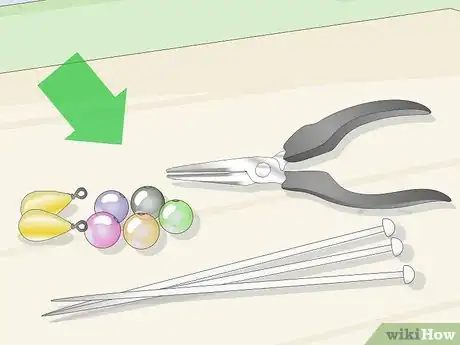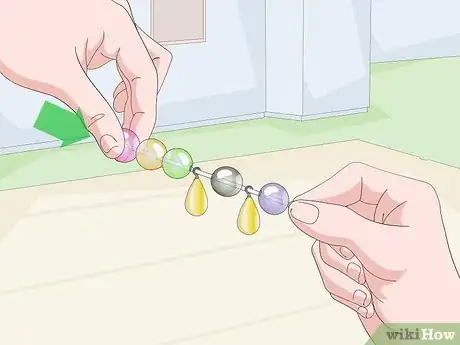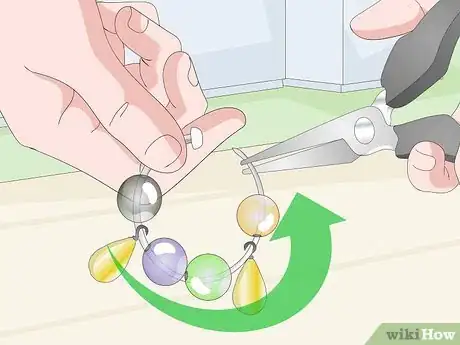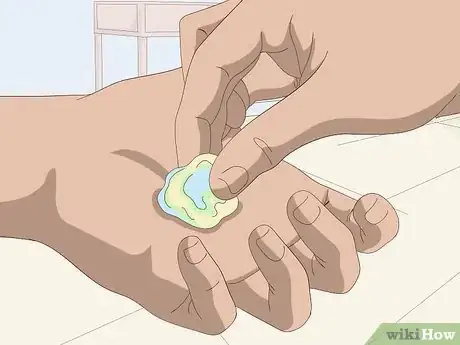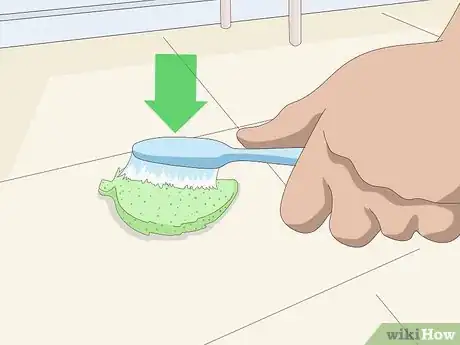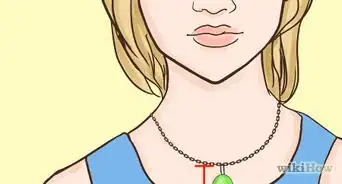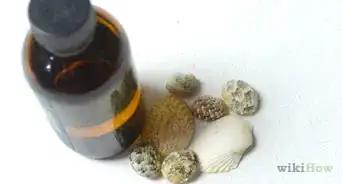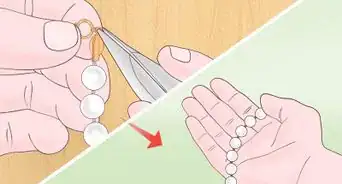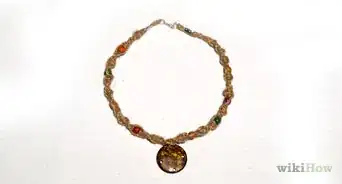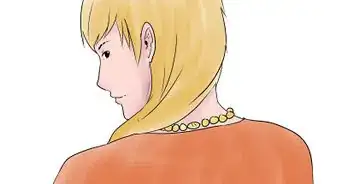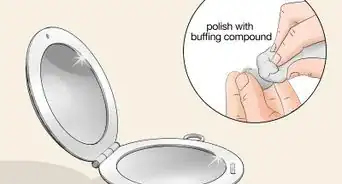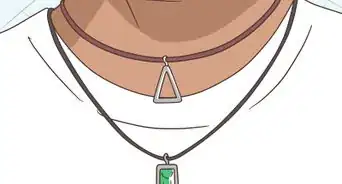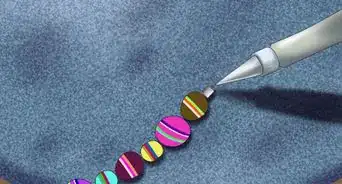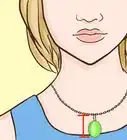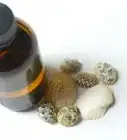X
wikiHow is a “wiki,” similar to Wikipedia, which means that many of our articles are co-written by multiple authors. To create this article, 18 people, some anonymous, worked to edit and improve it over time.
There are 7 references cited in this article, which can be found at the bottom of the page.
This article has been viewed 53,474 times.
Learn more...
Charms can be beaded, molded, stamped, painted, poked and prodded. Their versatility and affordability make them an important part of jewelry making. Hone your charm designing skills with beaded and clay charms.
Steps
Method 1
Method 1 of 2:
Creating and Attaching a Beaded Charm
-
1Lay out all your tools. Before getting started, ensure that you have all the appropriate tools. including beads, headpins, pliers, and wire cutters.[1] By having all your tools together, you can prevent the need to run to the craft store in the middle of your work.
- Headpins are a tool vital to charm-making. They are skinny pin-like pieces of metal that have one smooth head end. They can be compared to a very tiny nail, or a thinner version of a sewing pin, but with a flat end opposite the head.[2]
- All your beaded charm supplies will be available at a local craft or dollar store.
-
2Plan your charms. Once you’ve developed a desired theme for you charms, lay the beads out in the desired pattern.[3] If you’ll be doing more than one charm, position each charm separately from one another. Take time to experiment with the order and positioning of the beads.Advertisement
-
3String the beads on the headpin. Taking the pre-decided lines of beads, thread them through the headpin. If you are creating a color coordinated pattern with other charms, ensure the correct order is followed.
- If doing several charms, thread the beads onto the headpins all at once. This will prevent you from making any mistakes in size, color, style or order of beads.
-
4Attach using a single loop. Thread the headpin through your jewellery. Experiment with your desired length from the jewellery to the charm. Using pliers, curve the pin in a circle back towards you, and continue bending away from you. Stop when the headpin has met one single loop. Twist the end of the loop till it is aligned with the beaded-side of the loop.
- Trim the excess pin if you will be keeping a single loop. If you wish to have a wrapped loop, keep the excess for the time being. If you trim and you find the end of the pin to be poking you, simply mold it towards the inside of the loop.
-
5Finish with a wrapped loop (Optional). If you’re tough on your jewelry, consider adding the wrapped loop. A wrapped loop is added to a single loop by taking the excess wire from the end of the loop and wrapping it neatly down the charm’s side of the pin. Three wraps should be sufficient before trimming off any excess wire. Always tuck the end of the wire in. Wrapped loops will prevent charms from slipping off and give an antique look to your jewelry piece.
Advertisement
Method 2
Method 2 of 2:
Molding Polymer Charms
-
1Gather your materials. Working with clay can be very time sensitive. You don’t want your hard work to go to waste if the clay dries up or ages while you look for your eyepins. Before sitting down to get molding, gather up all required eyepins, jump rings, pliers and polymer clay. If you plan to texture or beautify your charm, make sure to grab your texturing tools such as a toothbrush, stamps or releasing agent you will need.
- A releasing agent will prevent the clay from sticking to the stamp as the stamp is pulled away.[4]
- An eyepin is a small pin used to anchor into your charm. It is thin and long, with one pointy end and the other end molded into a small loop.[5] The loop is the location where you can add a jump ring to connect it to your charm.
- A jump ring is another metal piece used to connect an eyepin to jewelry. Jump rings are small, circular rings of metal that can open and close to attach to a charm through the eyepin.[6]
- You may want to also gather a baking-safe pan or bowl to place your charms into while they cure. Anything oven-safe is appropriate.
-
2Condition enough clay for your charms. Conditioning is the preparation of clay.[7] To condition, tear off a sufficient amount of clay from your brick. If you wish to mix two colors, now is the time to cut off both amounts. Work both colors in your hands to mix into the desired look. The warmth in your hands will warm the clay up. This will have it conditioned and ready to go for moulding.[8]
- Try rolling the clay out in a long skinny line. You can also try rolling it up into a sphere, only to squish it down and reroll. Any method works as long as the clay is being worked.[9]
- The clay will need to be conditioned for up to ten minutes. You’ll start to feel a change in the clay’s consistency once you become more experienced.[10] The clay will be soft and workable when ready. It cannot be over-conditioned, so if you’re unsure, give it a few extra minutes.
- If your clay is difficult to shape or is crumbly, it’s likely too old for use.[11] Throw it out and try again.
-
3Shape the clay into the desired shape. When learning to mold, it is usually best to start small and simple. Either take a piece of clay and shape with your fingers, or roll it out to cut it.[12] If you choose to try rolling it out, press it into an even thickness. Using either a cookie cutter or knife, cut out your desired shape.[13]
- It is recommended to do all shaping on top of the pan you will use for baking the clay. If you’d prefer your charm to be matte instead of shiny, place parchment paper between the pan and the charm.[14]
-
4Add texture to the charm. Texturing can take a simple charm and turn it into one that has intricate detail. Get creative when choosing how to texture. Try gently brushing a clean toothbrush across the surface of your charm, or pushing a feather into the charm.[15] Sandpaper can create another interesting texture. Try using a needle or toothpick to add small designs.[16]
-
5Insert an eyepin. An eyepin will allow you to thread the charm onto a necklace or add it into a charm bracelet.[17] Look at your charm and determine which way you would like it to hang. Gently press the eyepin in until only the eyelet is visible. If you’re unhappy, you can remove it, reshape your charm, and try again.
- Eyepins can also be added after the clay has cured using a drill bit.[18] However, attaching the pin before curing will allow you to experiment with placement.
-
6Stamp the charm. If you wish to add a three dimensional stamp to your charm, do so before curing. Wood-mounted, traditional, metal and acrylic stamps can all be used safely with clay.[19] Before stamping, check your alignment twice before applying pressure then gently push the stamp down onto your charm.
- If you have a limited supply of stamps, use things from around your home. For example, uncooked alphabet noodles or beads.[20]
- Consider using a release agent before stamping. Before stamping, simply moisten the stamp with water. Alternatives to water include powders such as cornstarch and baby powder.[21] Always make sure to clean the stamp afterwards.
-
7Cure the charms. Whenever ready, prepare to cure your charms. While they can be air-dried, baking them provides a much more stable and hearty charm. Clay curing temperature and time will be dependent upon the manufacturer but is usually around 275 degrees Fahrenheit (130 degrees Celsius) for 25 minutes. If you’ve lost the packaging for your clay, Google the manufacturer for details. After cooling completely, the charms are ready to be added into your jewelry.
- If the charms are light in color, you may wish to decrease the oven temperature by 10 degrees Fahrenheit (12 degrees Celsius) and double the cooking time. This prevents the clay from browning or changing color.
- When your clay is removed from the oven it will still be soft. Clay does not finish curing until cooled. Do not be tempted to touch the clay, or leave it in the oven longer than recommended.
-
8Attach your charm. Using a jump ring, open the ring to accommodate sliding the eye pin through. If necessary, use needle nosed pliers to open the ring. After the charm is inserted onto the jump ring through the eye-pin, thread the jump ring onto the rest of the jewelry. When satisfied, use the pliers to gently close the ring. Voila! Enjoy your new charm.
- When opening a jump ring, do not pull it open by moving both ends away from another. Instead, open it by twisting the ends side to side. This will aid the ring in keeping its strength.
Advertisement
Community Q&A
-
QuestionHow can I make a magical amulet?
 Community AnswerYou could use larger beads or charms from broken necklaces, then get a chain or other necklace base that all the items can fit on.
Community AnswerYou could use larger beads or charms from broken necklaces, then get a chain or other necklace base that all the items can fit on. -
QuestionCan these be used as protection from a curse?
 Community AnswerIt's possible. Different charms have different properties. It also depends on the severity of the curse.
Community AnswerIt's possible. Different charms have different properties. It also depends on the severity of the curse.
Advertisement
Warnings
- When using wire cutters, wire may erratically fling. To protect your vision, put on safety goggles or even a pair of sunglasses, and cut the wire away from your body.⧼thumbs_response⧽
- Use caution when removing hot clay from the oven. Always wear hand protection.⧼thumbs_response⧽
Advertisement
References
- ↑ https://www.youtube.com/watch?v=AUbT_YVIyTM
- ↑ http://www.firemountaingems.com/shop/headpins
- ↑ https://www.youtube.com/watch?v=AUbT_YVIyTM
- ↑ http://www.polymerclayweb.com/tools/supplies/releaseagents.aspx
- ↑ http://www.fusionbeads.com/Eye-Pins#!Eye-Pins
- ↑ http://www.fusionbeads.com/3mm-Sterling-Silver-22-Gauge-Open-Jump-Ring
- ↑ http://www.polymerclayweb.com/tutorials/jewelry/chattycharms.aspx
- ↑ http://www.jaedworks.com/clayspot/polyclay-faq/conditioning.html
- ↑ http://www.jaedworks.com/clayspot/polyclay-faq/conditioning.html
- ↑ http://www.jaedworks.com/clayspot/polyclay-faq/conditioning.html
- ↑ http://www.jaedworks.com/clayspot/polyclay-faq/conditioning.html
- ↑ http://www.polymerclayweb.com/tutorials/jewelry/chattycharms.aspx
- ↑ http://www.polymerclayweb.com/tutorials/jewelry/chattycharms.aspx
- ↑ http://www.polymerclayweb.com/tutorials/jewelry/chattycharms.aspx
- ↑ http://www.polymerclayweb.com/tutorials/jewelry/chattycharms.aspx
- ↑ http://www.polymerclayweb.com/tutorials/jewelry/chattycharms.aspx
- ↑ http://www.polymerclayweb.com/tutorials/jewelry/chattycharms.aspx
- ↑ http://www.polymerclayweb.com/tutorials/jewelry/chattycharms.aspx
- ↑ http://www.polymerclayweb.com/tutorials/jewelry/chattycharms.aspx
- ↑ http://www.polymerclayweb.com/tutorials/jewelry/chattycharms.aspx
- ↑ http://www.polymerclayweb.com/tools/supplies/releaseagents.aspx
About This Article
Advertisement
